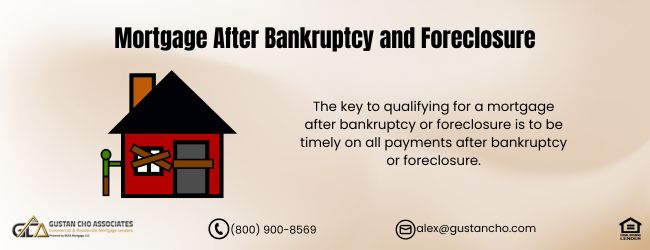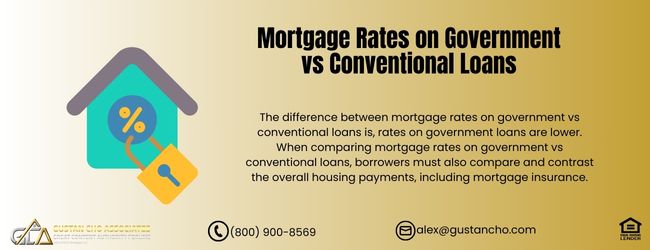Fannie Mae Mortgage Included In Bankruptcy Guidelines

This blog will discuss the Fannie Mae mortgage included in bankruptcy guidelines on conventional loans. We will discuss bankruptcy and foreclosure mortgage guidelines on government and conventional loans. Different waiting period requirements exist to qualify for a home loan after bankruptcy. The waiting period requirements depend on whether the bankruptcy was a Chapter 7 or Chapter 13 Bankruptcy. The waiting period requirements after bankruptcy also depend on the type of mortgage loan program. If you file for a Chapter 7 bankruptcy and it is discharged, mortgage applicants need to meet the mandatory waiting period on government and conventional loans. In the following paragraphs, we will discuss the Fannie Mae Mortgage Included in Bankruptcy Guidelines on conventional loans.
Mortgage Included in Bankruptcy Guidelines Waiting Period on Conventional Loans
There are mandatory waiting periods after bankruptcy to qualify for home loans. HUD requires two years mandatory waiting period after the Chapter 7 Bankruptcy discharge date. Borrowers can qualify for FHA loans one year into a Chapter 13 Bankruptcy Repayment Plan. Borrowers seeking a home loan during a Chapter 13 bankruptcy repayment plan need trustee approval. Chapter 13 does not have to be discharged to qualify for FHA loans. All FHA loan mortgage applications during the Chapter 13 Bankruptcy repayment plan need manual underwriting. Speak With Our Loan Officer for Conventional Loans
How Does Mortgage Included in Bankruptcy Guidelines Work
Including a mortgage in bankruptcy proceedings is possible. However, it’s subject to certain guidelines and regulations governed by federal bankruptcy laws and agency mortgage agency’s policies. In the following paragraphs, we will cover key points to consider. In a Chapter 7 bankruptcy, your assets are typically liquidated to pay off your debts. Fannie Mae mortgages can be discharged through this process. However, it’s essential to understand that the discharge of your mortgage debt doesn’t necessarily mean you won’t lose your home. If you want to keep your home, you may need to reaffirm the debt with Fannie Mae, which means you’ll continue making payments on the mortgage.
How Does Chapter 13 Bankruptcy Process Work
Chapter 13 bankruptcy, you create a repayment plan to pay off your debts over three to five years. Fannie Mae mortgages can also be included in this type of bankruptcy, catch up on missed mortgage payments through the repayment plan, and avoid foreclosure. File for bankruptcy, an automatic stay goes into effect, which halts most collection actions, including foreclosure proceedings, by creditors, including Fannie Mae.
Fannie Mae’s Guidelines
Fannie Mae has specific guidelines for dealing with mortgages, which are included in bankruptcy proceedings. These guidelines outline how servicers should handle bankruptcy cases, including communication with borrowers, processing payments, and handling foreclosure actions.
Reaffirmation Agreement
If you want to keep your home and continue making payments on your Fannie Mae mortgage after bankruptcy, you may need to enter into a reaffirmation agreement. This agreement re-establishes your liability for the mortgage debt.
Consultation with Legal Professionals
Bankruptcy laws and procedures can be complex, and the implications of including a Fannie Mae mortgage in bankruptcy can vary depending on your circumstances. It’s crucial to consult with a qualified bankruptcy attorney who can provide guidance tailored to your situation. Overall, while including a Fannie Mae mortgage in bankruptcy is possible, it’s essential to understand the implications and follow the necessary procedures outlined by federal bankruptcy laws and Fannie Mae’s guidelines.
VA Mortgage Mortgage Included In Bankruptcy Guidelines
Homebuyers can qualify for VA loans after bankruptcy after meeting the minimum waiting period requirements. The Department of Veterans Affairs requires a 2-year mandatory waiting period after Chapter 7 Bankruptcy. VA Guidelines in Chapter 13 are exactly the same as FHA. Borrowers can qualify for VA loans after 12 payments into Chapter 13 Repayment. To qualify for a VA loan during the Chapter 13 Bankruptcy repayment plan, you need Trustee Approval. There is no waiting period after the Chapter 13 discharge date to qualify for VA loans. The team at Gustan Cho Associates are experts in helping borrowers qualify for VA loans with credit scores down to 500 FICO and homebuyers with a high debt-to-income ratio. Click here to get a VA Loans mortgage included in bankruptcy
Mortgage Included in Bankruptcy Guidelines on Waiting Period
Fannie Mae Mortgage Included in Bankruptcy Guidelines require a 4-year waiting period to qualify for conventional loans after Chapter 7 Bankruptcy. There is a 2-year wait period after the Chapter 13 discharge date. To qualify for a conventional loan after a Chapter 13 Bankruptcy dismissal date, there is a 4-year waiting period. Fannie Mae mortgage included in bankruptcy guidelines requires a four-year waiting period after the bankruptcy discharge date. What this means is if you had a mortgage included in your bankruptcy, the waiting period is four years from the discharge date of the bankruptcy. The housing event date does not matter. The mortgage cannot be reaffirmed.
Waiting Period Guidelines After Bankruptcy on USDA Loans
USDA loans are one of our most popular mortgage loan programs. USDA loans are insured and partially guaranteed through the U.S. Department of Agriculture Rural Development. Not all areas are eligible for USDA financing. USDA requires a three-year waiting period after bankruptcy, foreclosure, deed in lieu, or short sale. In the following paragraphs, we will discuss Mortgage Included In Bankruptcy Guidelines.
Mortgage Waiting Period Guidelines After Foreclosure
Government and conventional loans have different waiting periods after bankruptcy and foreclosure. There are mandatory waiting periods after housing events. HUD requires a 3-year waiting period to qualify for FHA loans after the following:
- Foreclosure
- Deed-In-Lieu Of Foreclosure
- Short Sale
VA Guidelines After Foreclosure
VA requires a two-year waiting period to qualify for VA loans after the following:
- Foreclosure
- Deed-In-Lieu of Foreclosure
- Short Sale
Fannie Mae and Freddie Mac Guidelines After Foreclosure
Fannie Mae and Freddie Mac require the following waiting period after housing event on conventional loans:
- Four years after a deed-in-lieu of foreclosure
- There is a four-year waiting period after a short sale short sale
- Seven years after a foreclosure
Fannie Mae Mortgage Included in Bankruptcy Guidelines vs HUD Guidelines
Fannie Mae guidelines on mortgage included in bankruptcy guidelines on conventional loans differ from government loans. Fannie Mae mortgage included in bankruptcy guidelines state if someone had a mortgage included in a bankruptcy, the waiting period is four years from the discharge date. The mortgage cannot be re-affirmed.
The housing event does not have to be finalized. As long as the mortgage and mortgages were included in bankruptcy. Fannie Mae mortgage included in bankruptcy guidelines goes by the 4-year waiting period after the discharge date.
VA Loan Guidelines on Mortgage Included In Bankruptcy
VA has the same guidelines as Fannie Mae Mortgage Included In Bankruptcy Guidelines. Borrowers could qualify for VA loans in 4 years if they had a mortgage included in bankruptcy. If the mortgage included in bankruptcy was a VA loan, it might affect their VA eligibility entitlement. If someone had a mortgage included in a bankruptcy, there is a mandatory waiting period of three years from the recorded date of the housing event. The discharge date of bankruptcy does not matter. Click here to get a VA Loans mortgage included in bankruptcy
Waiting Period To Get Home Loan With a Prior Mortgage Included In Bankruptcy
You can qualify for a mortgage with a prior bankruptcy. However, what is the waiting period requirements to get a new home loan with a prior mortgage included in a bankruptcy? The best way to illustrate the waiting period requirements to qualify for a new mortgage with a prior mortgage included in the bankruptcy is to go over a case scenario.
Fannie Mae Mortgage Included in Bankruptcy Guidelines Case Scenario
Let’s take an example of Fannie Mae Mortgage Included in Bankruptcy Guidelines case scenario. If a borrower had a mortgage included in bankruptcy in March 2010. Still, the property did not foreclose until December 2018, this borrower will not qualify for an FHA loan until three years from December 2018. Therefore, this borrower will not qualify for FHA loan until December 2021.
Per Fannie Mae Mortgage Included in Bankruptcy Guidelines, this borrower will qualify for a conventional loan, meeting the four-year waiting period after the bankruptcy discharge date.
Other factors required by borrowers are timely payments since the bankruptcy discharge date. Meet all conventional mortgage guidelines. No late payments since the bankruptcy and housing event. Re-established credit after bankruptcy
Which Is Better FHA or Conventional Loan?
Besides the benefits of Fannie Mae Mortgage Included In Bankruptcy Guidelines, there are other reasons why borrowers may need to go with Conventional versus FHA loans. Income Based Repayment (IBR) is allowed with Conventional and FHA loans. There are many home buyers with large student loan balances. Fannie Mae and HUD require 0.50% of the outstanding student loan balance to be used for a borrower’s hypothetical debt on DTI Calculations. IBR Payments are not allowed. Fannie Mae and Freddie Mac also allow IBR student loan payments as long as it reports on all three credit bureaus. Homebuyers or homeowners who need a lender with no overlays on government and conventional loans, please contact us at Gustan Cho Associates at 800-900-8569 or text us for a faster response. Or email us at gcho@gustancho.com. The team at Gustan Cho Associates is available seven days a week, evenings, weekends, and holidays.
This blog on Fannie Mae Mortgage Included in Bankruptcy Guidelines was updated on March 13th, 2024.






Responses